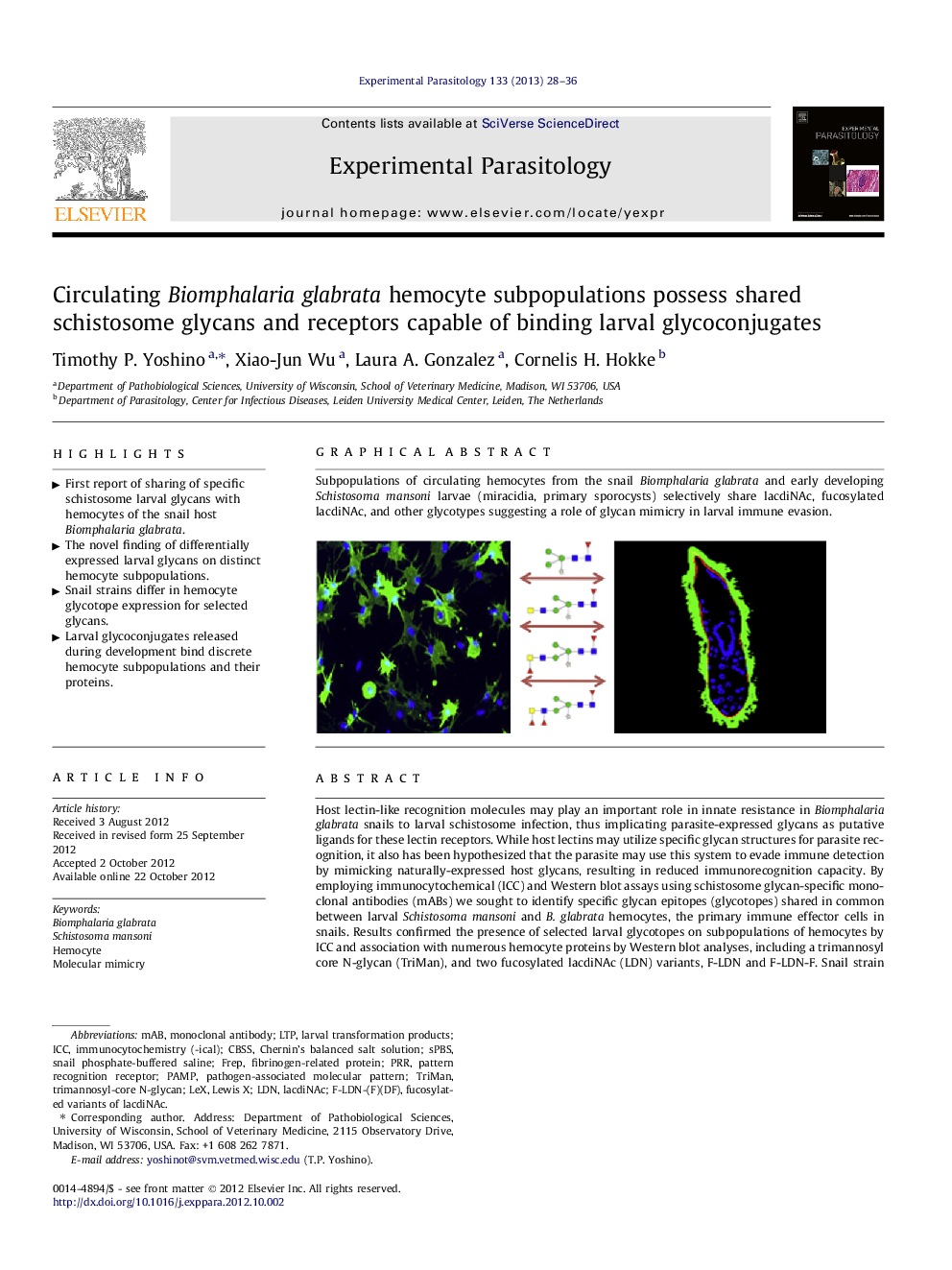| کد مقاله | کد نشریه | سال انتشار | مقاله انگلیسی | نسخه تمام متن |
|---|---|---|---|---|
| 4371187 | 1302486 | 2013 | 9 صفحه PDF | دانلود رایگان |

Host lectin-like recognition molecules may play an important role in innate resistance in Biomphalaria glabrata snails to larval schistosome infection, thus implicating parasite-expressed glycans as putative ligands for these lectin receptors. While host lectins may utilize specific glycan structures for parasite recognition, it also has been hypothesized that the parasite may use this system to evade immune detection by mimicking naturally-expressed host glycans, resulting in reduced immunorecognition capacity. By employing immunocytochemical (ICC) and Western blot assays using schistosome glycan-specific monoclonal antibodies (mABs) we sought to identify specific glycan epitopes (glycotopes) shared in common between larval Schistosoma mansoni and B. glabrata hemocytes, the primary immune effector cells in snails. Results confirmed the presence of selected larval glycotopes on subpopulations of hemocytes by ICC and association with numerous hemocyte proteins by Western blot analyses, including a trimannosyl core N-glycan (TriMan), and two fucosylated lacdiNAc (LDN) variants, F-LDN and F-LDN-F. Snail strain differences were seen in the prevalence of constitutively expressed F-LDN on hemocytes, and in the patterns of protein immunoreactivity with these mABs. In contrast, there was little to no hemocyte reactivity with mABs for Lewis X (LeX), LDN, LDN-F or LDN-DF. When intact hemocytes were exposed to larval transformation products (LTPs), distinct cell subpopulations displayed weak (LeX, LDN-DF) to moderate (LDN, LDN-F) glycotope reactivity by ICC, including snail strain differences in the prevalence of LDN-reactive cellular subsets. Far-Western blot analyses of the hemocytes following exposure to larval transformation proteins (LTPs) also revealed multiple mAB-reactive hemocyte protein bands for LeX, LDN, LDN-F, and LDN-DF. These results demonstrate the existence of complex patterns of shared larval glycan constitutively expressed on hemocytes and their proteins, as well as the ability of hemocytes to acquire shared glycans by the selective binding of parasite-released LTP. Unraveling the functional significance of these naturally expressed and acquired shared glycans on specific hemocyte populations represents an important challenge for future investigations.
Subpopulations of circulating hemocytes from the snail Biomphalaria glabrata and early developing Schistosoma mansoni larvae (miracidia, primary sporocysts) selectively share lacdiNAc, fucosylated lacdiNAc, and other glycotypes suggesting a role of glycan mimicry in larval immune evasion.Figure optionsDownload as PowerPoint slideHighlights
► First report of sharing of specific schistosome larval glycans with hemocytes of the snail host Biomphalaria glabrata.
► The novel finding of differentially expressed larval glycans on distinct hemocyte subpopulations.
► Snail strains differ in hemocyte glycotope expression for selected glycans.
► Larval glycoconjugates released during development bind discrete hemocyte subpopulations and their proteins.
Journal: Experimental Parasitology - Volume 133, Issue 1, January 2013, Pages 28–36